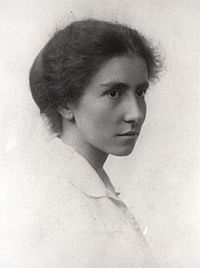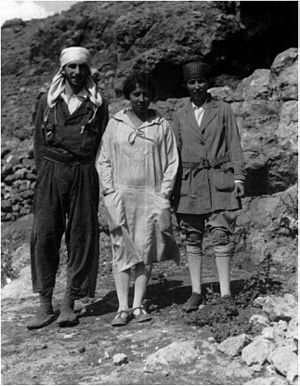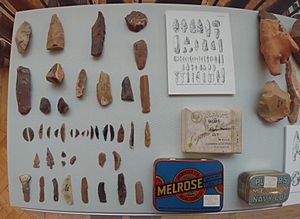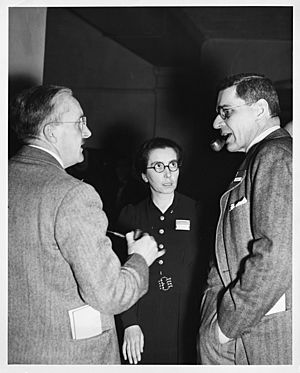Dorothy Garrod facts for kids
Quick facts for kids
Dorothy Annie Elizabeth Garrod
|
|
|---|---|

Dorothy Garrod, c. 1913, while at Newnham College, Cambridge
|
|
| Born | 5 May 1892 |
| Died | 18 December 1968 (aged 76) |
| Nationality | British |
| Alma mater | Newnham College, Cambridge, Pitt Rivers Museum, University of Oxford |
| Known for | The Upper Paleolithic of Britain; The Stone Age of Mount Carmel, |
| Scientific career | |
| Fields | archaeology |
| Institutions | British School of Archaeology in Jerusalem, Newnham College, University of Cambridge |
| Influences | Robert Ranulph Marett Abbé Breuil |
Dorothy Annie Elizabeth Garrod (born May 5, 1892 – died December 18, 1968) was a famous British archaeologist. She studied the Stone Age, a very old time in human history. Dorothy Garrod made history herself. She became the Disney Professor of Archaeology at the University of Cambridge. This made her the first woman to hold such a high position at either Oxford or Cambridge universities.
Contents
Early Life and Education
Dorothy Garrod was born in London. Her father, Sir Archibald Garrod, was a doctor. She was taught at home by a governess named Isabel Fry. Later, she went to Birklands School in St Albans.
In 1913, Dorothy started studying history at Newnham College, Cambridge. She finished her course in 1916. During World War I, she helped with war work. After the war, she went to Malta and became interested in ancient objects there.
Career in Archaeology
When her family moved to Oxford, Dorothy studied anthropology. This is the study of human societies and cultures. She learned at the Pitt Rivers Museum and finished her studies in 1921. She found her passion: studying the Stone Age. She then spent two years learning from a French expert, Abbé Breuil, in Paris.
After her studies, Dorothy began digging in Gibraltar. In 1925, she found an important Neanderthal skull in Devil's Tower Cave. This skull is now called Gibraltar 2.
In 1926, Dorothy published her first book, The Upper Paleolithic of Britain. This book helped her earn a science degree. In 1928, she led an expedition to South Kurdistan. There, her team excavated Hazar Merd Cave and Zarzi cave.
A big moment in her career came in 1929. Dorothy was chosen to lead excavations at Mount Carmel in Palestine. This was a joint project between American and British archaeology schools. Her team worked for 22 months. They found a long timeline of human life in the caves of Tabun, El Wad, Es Skhul, Shuqba, and Kebara.
Dorothy also named the Natufian culture. This was an ancient group of people from the Stone Age. She worked closely with Dorothea Bate, another scientist. Dorothy's excavations often used local women workers. One of these women, Yusra, even found a Neanderthal skull called Tabun 1. Dorothy's digs were also among the first to use aerial photography.
In 1937, she published The Stone Age of Mount Carmel. This book was very important in her field. In 1938, she excavated the Bacho Kiro cave in Bulgaria.
Dorothy Garrod became the Disney Professor of Archaeology at Cambridge in 1939. She held this job until 1952. Her appointment was a huge step for women at the university. The Cambridge Review newspaper said it was "an immense step forward towards complete equality." However, women still could not vote on university matters until 1948.
During World War II, Dorothy took a break from the university. She served in the Women's Auxiliary Air Force (WAAF). She worked in a unit that interpreted photos.
After the war, Dorothy returned to Cambridge. She changed the archaeology department. She added a new course on world prehistory. Before this, prehistory mostly focused on Europe. Dorothy made Cambridge the first British university to offer courses in prehistoric archaeology for students. She also continued to excavate in France during her summer breaks.
Later Life and Legacy
Dorothy Garrod retired in 1952 and moved to France. But she kept doing research and excavations. In 1958, she dug at Adlun in Lebanon. She also helped excavate at Ras el-Kelb in 1959. She continued to work in Lebanon in 1963, but her health began to decline.
In 1968, Dorothy had a stroke while visiting relatives in Cambridge. She passed away on December 18, 1968, at age 76.
Diversity and Inclusion
Dorothy Garrod was a pioneer for women in archaeology. She was the first female professor at Cambridge. On her excavations, her teams were often mostly women. She also supported local people and their families. Her Mount Carmel team was made up mostly of local Arab women. In 1931, she invited Francis Turville-Petre, an openly gay man, to join her excavations.
Awards and Recognition
Dorothy Garrod received many honors. In 1937, she got honorary doctorates from the University of Pennsylvania and Boston College. She also received a DSc. from the University of Oxford. In 1952, she became a Fellow of the British Academy. In 1965, she was awarded the CBE.
She believed it was important for archaeologists to travel. So, she left money to create the Dorothy Garrod Travel Fund. In 1968, she received the Gold Medal from the Society of Antiquaries of London.
From 2011 to 2012, photos of Dorothy's excavations were shown at the Pitt Rivers Museum. In 2017, Newnham College named a new building after her. In 2019, a new portrait of Dorothy Garrod was unveiled at the McDonald Institute for Archaeological Research.
See also
 In Spanish: Dorothy Garrod para niños
In Spanish: Dorothy Garrod para niños




